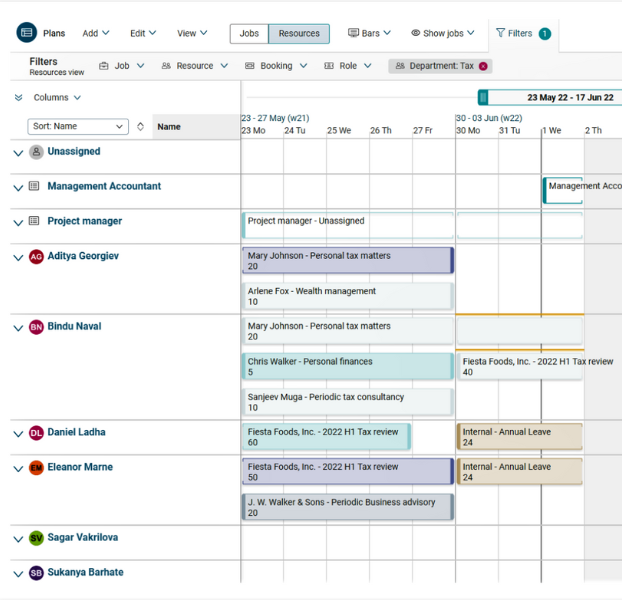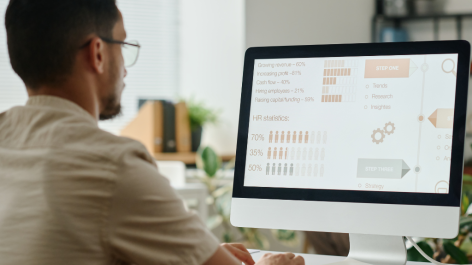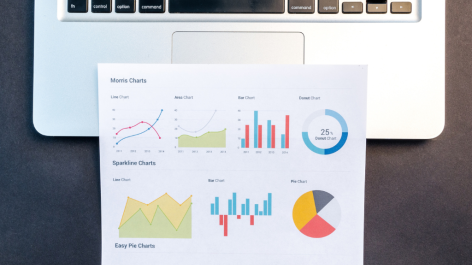Choosing the best resource management software is critical to maximising resource utilisation, ensuring the right staff are properly allocated, and providing visibility into resource planning. But with the array of options on the market, choosing the best software for your firm can be a daunting task.
Luckily, we’re here to help. This guide provides an overview of the key capabilities and ‘must-haves’ when choosing the best resource management software. The right software enables you to optimise resource allocation, improve forecasting, and make data-driven decisions that drive profitability.
So whether you're looking to implement your first resource management platform or considering migrating from other solutions, let’s get into it.?
The top 9 ‘must-haves’ when choosing Resource Management Software
Choosing the right resource management and planning software is a really important decision. Why? Because the system you choose should provide a breadth of capabilities to meet all of your resource planning, allocation, and optimisation needs - now and in the future.
When evaluating options, there are 9 must-have features and functions to look for:
- Resource planning and forecasting
- Utilisation tracking
- Skills management
- Time tracking
- Reporting and analytics
- Intelligent resource recommendations
- Dynamic skills matching
- Simple, speedy scheduling
- Continuous learning and optimisation
Prioritising these areas will ensure you choose a platform that can handle all aspects of resource management. The software you choose should go beyond basic project staffing and timesheets to provide big-picture visibility through AI, comprehensive analytics, and powerful visualisation and reporting tools.
Now let's explore each of these key capabilities in greater detail. This will help provide a clear framework of the key features your ideal resource management software should include.?
1. Resource planning and forecasting
Robust resource planning and forecasting tools should be at the core of any resource management system you evaluate. The software should provide capabilities to:
✅Build resource plans and models that align with projected project demand and workload. This allows you to visualise and optimise resource allocation.
✅Construct "what-if" scenarios to model the best case, worst case, and most likely resource capacity needed based on project pipeline data.
✅Adjust assumptions and inputs to create multiple optimisation scenarios and compare the outcomes.
✅Provide role-based capacity planning views to forecast at the company, department, team, and individual levels.
✅Leverage historical utilisation data and trends to improve forecasting accuracy.
✅Automatically notify resource managers of shortfalls or overages between staff supply and project demand.
✅Integrate with financial systems to factor in budget constraints and billing targets.
✅Allocate generic or named resources to projects in line with current and projected availability.
Trying to predict what your staffing needs can be tough without the right tools. But having the right resource management software in your corner makes it possible. These features can forecast upcoming demand based on past trends and current projections. That way, you don't wind up with too many staff with downtime or too few staff to handle the workload. It's all about having the right people with the right skills available when you need them.
2. Utilisation tracking
To maximise productivity and resource efficiency, your management software should provide robust utilisation tracking capabilities. Key features to look for include:
✅Automated utilisation rate calculations at the resource, team, department, and organisation levels.
✅Flexible utilisation metrics based on billable hours, billable assignments, productive time, or other custom definitions.
✅Real-time monitoring of utilisation rates and trends with alerts for under-utilised resources.
✅Ability to track utilisation by seniority, role, office location, speciality, or other filters.
✅Drill-down analysis to identify drivers behind poor utilisation for targeted improvement.
✅"What-if" scenario modelling to forecast the impact of utilisation initiatives and process changes.
✅Data integrations with HR systems to factor in PTO and availability constraints.
✅Interactive dashboards and visualisations to provide visibility into utilisation data.
With the right resource management software, you can closely monitor how staff are allocated. The data reveals chances to use resources more efficiently. Maybe you could move some tasks around to better balance workloads. Or you identify ways to get more mileage from your available staff hours.
3. Skills management
An advanced skills management system should be a key component of the resource management software you select. Key features to look for include:
✅Maintaining a central skills inventory that catalogues employee skills, experience, certifications, and specialities.
✅Enabling employees to provide self-assessments of proficiency across various skill categories.
✅Allowing skills data to be searched, filtered, and reported on.
✅Using skills profiles for intelligent recommendations on project staffing and team composition.
✅Mapping required skills for projects and matching with available talent pools.
✅Identifying skills gaps to guide learning programs and development initiatives.
✅Tracking skills over time and projected maturation to aid succession planning.
✅Segmenting the workforce into competency models for strategic workforce planning.
With the right resource management software, you get a skills database that delivers those valuable insights. You get a bird's-eye view of the know-how available across your entire organisation. This helps you make the best choices when assigning work. You can ensure the right skill sets are tapped to get projects done. Plus, you can spot skill gaps that need closing. Or even get a jumpstart on competency development to stay ahead of emerging needs.
4. Track time and billable hours
Your chosen resource management system should also provide sophisticated time tracking capabilities. Key features to look for include:
✅Log time against projects to track budget vs actuals
✅Calculate billable hours for accurate client billing
✅Gain visibility into project profitability based on time tracked
✅Ensure projects are running to schedule and on budget
✅Ability to create and distribute customizable timesheet templates aligned with services delivered.
✅Tools for time entry via desktop, web, or mobile app with support for different time increments.
✅Validation, approval workflows, and automation rules to enforce timesheet compliance.
✅Flexible billing rules, rate tables, and integration with accounting systems.
✅Customisable notifications and reminders for late timesheets.
✅Analytics on timesheet data including overtime trends, time per project, and productivity benchmarks.
✅Reporting on time utilisation, capacity, and demand forecasting.
✅Data integrations with project management and collaboration systems.
The right software makes easy work of capturing hours worked and billed. This gives you a true source of record for how work gets done. Plus, you can trust the insights for forecasting revenue and monitoring utilisation. No more manually compiling data from various sources. Or tracking in spreadsheets prone to human error.
5. Reporting and analytics
Robust and customisable reporting and analytics capabilities are essential to gain strategic insights from your resource data. The system should enable you to:
✅Create customised dashboards to visualise availability, utilisation, and other key metrics.
✅Easily build user-defined reports with drag-and-drop tools accessible to end users.
✅Spot trends and bottlenecks early through interactive data visualisations.
✅Drill down from high-level reports to granular details for deeper analysis.
✅Export data to Excel, PDFs, and other formats for offline analysis.
✅Integrate with BI platforms like Microsoft Power BI for enhanced analytics.
✅Dig deeper into the details and improve data-driven decision making through flexible and visual reporting tools.
With the right resource management software, you get analytics that reveals key trends. The kind of insights that fuel strategic planning. You can spot patterns and anomalies at a glance. Plus, interactive charts and graphs let you drill down to details as needed. Which means you can plan proactively instead of reactively. It's about anticipating future needs, not just reacting to the present.
6. Intelligent resource recommendations
To optimise project staffing and resource allocation, look for a system that provides AI-powered recommendation capabilities such as:
✅Analysing required skills, experience levels, and availability to automatically suggest the best resource fits for a project.
✅Factoring in historical data and patterns to provide intelligent, forward-thinking recommendations.
✅Drawing on resources' skills profiles, capacity, and past assignments to identify optimal candidates.
✅Enabling scenario modelling to determine the best team composition based on changing needs.
✅Learning from past decisions and project outcomes to continuously improve recommendations.
✅Allowing managers to rate and tweak recommendations to further train the underlying algorithms.
Advanced AI takes resource management to the next level. With sophisticated algorithms, the software can analyse your project plans and staff skills. It looks at all the data to provide smart recommendations for optimisation. This isn't broad speculation. The system scrutinises the specifics of each project and available resources. It then gives tailored suggestions to maximise utilisation and success.
7. Dynamic skills matching
Look for a resource management system that can dynamically match projects with properly skilled resources using AI. Key capabilities include:
✅An AI-enabled matching engine that evaluates proficiencies and understands real skill levels.
✅Learning from previous assignments and employee performance data to improve matching accuracy.
✅Factoring in skills gained or lost over time based on project work and training.
✅Suggesting the best resource-to-project fit based on up-to-date skills data.
✅Enabling scenario modelling to determine optimal skills alignment.
✅Allowing managers to provide feedback to continuously improve matching intelligence.
Want to boost quality and satisfaction? Dynamic skills matching is the key. This feature ensures your projects are staffed right the first time. The software analyses the required competencies for each project. Then it matches tasks to resources with those exact skills. The result? Work goes to those best qualified, not just available. Projects are tackled efficiently by capable hands from the start. And customers are happier getting top-notch results.
8. Simple, speedy scheduling
Your resource management system should simplify scheduling with an intuitive interface. Key capabilities include:
✅Enabling managers to easily create and modify bookings with just a few clicks.
✅Providing at-a-glance visibility into resource availability and capacity from a single view.
✅Streamlining the ability to check for conflicts and quickly identify optimal scheduling options.
✅Adding, editing, and deleting bookings and assignments with minimal effort.
✅Supporting rapid response to ad-hoc resource requests.
✅Allowing scenario simulation to compare alternative schedules.
✅Avoiding double bookings with tools that eliminate scheduling conflicts.
With simplified scheduling capabilities, managers can swiftly allocate resources across projects and respond to changing priorities. This enables faster project ramp-up and redeployment.
9. Continuous learning and optimisation
Finally, look for a resource management platform that continuously learns from data and past decisions to optimise its recommendations and performance over time. Key capabilities include:
✅AI and machine learning algorithms that refine resource allocation strategies based on accumulated data.
✅Getting progressively smarter at providing suggestions tailored to your firm's specific requirements.
✅Learning from past resource assignments and project outcomes to improve recommendation accuracy.
✅Factoring in feedback from users to enhance decision making.
✅Regularly backtesting its recommendations against actual results to identify areas for improvement.
✅Becoming more effective at managing resources with each planning cycle and allocation decision.
With continuous optimisation, the system does not just enable better resource management for today, but constantly evolves to meet your future needs. It should learn from experience to provide increasingly strategic insights.
More than features: Key buying considerations
But selecting the right software is about more than just functionality. You also need to evaluate the usability, configurability, security, and service aspects. These key buying factors help ensure the solution aligns with your firm's needs:
User Experience
- Is the interface modern, intuitive, and easy to use?
- Will it drive high adoption across your organisation?
Custom-Fit
- How customisable is the platform to match your workflows?
- Can you configure rules, templates, fields, and settings?
Safe & Secure
- What data protection, access controls, and encryption are used?
- Does it comply with security standards like SOC 2?
Service & Support
- Is responsive technical support and training available?
- What SLA commitments does the vendor provide?
Product Roadmap
- Is there a robust roadmap for continuous innovation?
- Will regular enhancements be made through new releases?
By evaluating these key factors beyond core features, you can ensure the solution is a great match both now and in the future. The right software has the functionality you need plus ease-of-use, security, and service tailored for your firm.
Choose the best resource management software
And there you have it - a comprehensive guide to choosing the best resource management software for your firm. Finding the right system can be tricky with so many options out there. But focusing on must-have capabilities like AI recommendations, advanced analytics, and robust forecasting tools will ensure you select a future-proof solution.
The key is finding a platform that simplifies resource scheduling while providing the strategic insights you need to take your business to the next level. The technology should adapt to your workflows rather than the other way around.
This is where Retain steps in. Retain aims to make the process easier and smarter. Retain provides an AI-powered software solution designed specifically for professional services organisations like yours.

By combining intelligent algorithms with intuitive software, Retain offers a way to streamline strategic resource planning and unlock deeper insights.
Let's explore some of Retain’s key features and capabilities of this forward-thinking resource management software:
- Intelligent recommendations - Uses AI algorithms to suggest optimal resource assignments based on skills, experience, availability and more.
- Dynamic skills matching - Matches projects to appropriately skilled resources by evaluating proficiencies.
- Continuous optimisation - Learns from past decisions and feedback to refine strategies over time.
- Simplified scheduling - Enables easy creation and adjustment of bookings with an intuitive interface.
- Time and billing - Tracks time against projects for budget visibility and billable hour calculations.
- Reporting and analytics - Customisable dashboards and visualisations provide insights into utilisation, capacity and other KPIs.
- Data security - Complies with industry security standards and regulations to protect sensitive data.
- Scalability - Grows with organisations by continuously adapting to changing business needs.
Of course, every firm has unique needs and priorities. So treat this guide as a starting point and framework as you evaluate options. There are a lot of exciting innovations happening in the resource management space. The right software will help you make the most of them.
The bottom line? Investing in a powerful yet flexible resource management platform pays dividends through optimised utilisation, improved forecasting, and data-driven agility. That allows you to maximise the impact of your people, projects, and profits. And that’s what it’s all about. If we’ve convinced you to put Retain on your shortlist, why not see a live demo of our AI-powered resource management software? Or you can follow us on LinkedIn to stay up to date with the latest trends.


